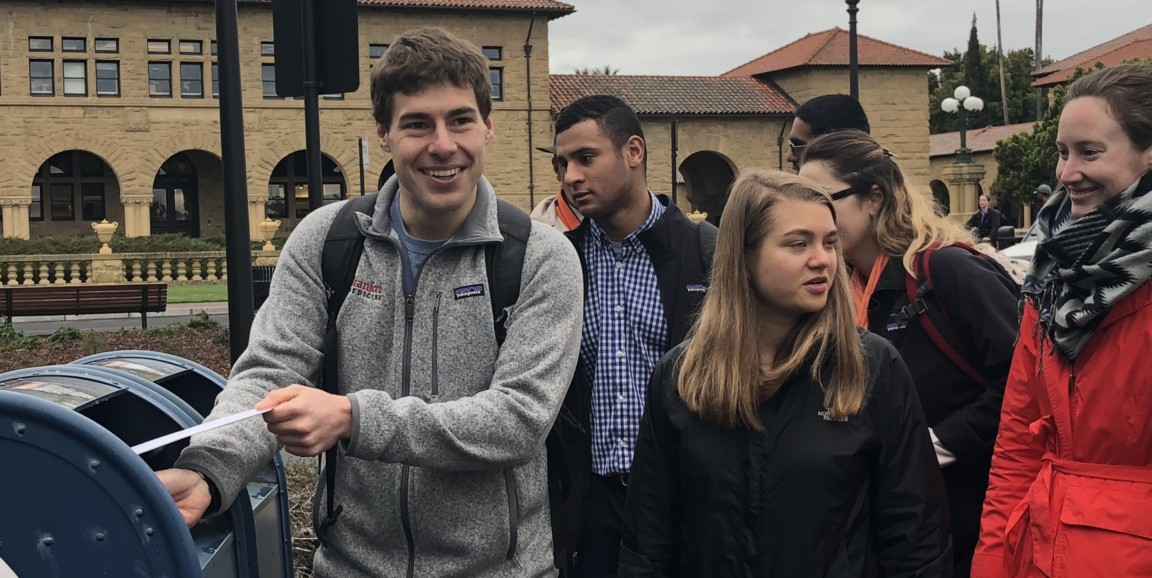Stanford medical student Drew Birrenkott grew up around guns. He shot a .22 caliber rifle for the first time as a Cub Scout, took a hunter's safety course at 16 and was given his first 12-gauge shotgun at 20. Every time he visits his hometown of McFarland, Wisconsin, he goes trap shooting with his father.
Now 27 and in his first year of medical school, Birrenkott continues to value the sportsmen's culture and respect for firearms; however, he also strongly believes more should be done to protect people from gun violence - and that medical students should speak their minds about it.
To that end, Birrenkott has coordinated a letter-writing campaign, urging his peers to express their views on guns to lawmakers. More than 40 Stanford medical and physician assistant students from 18 different states participated, most contacting their U.S. House representative and both of their U.S. senators.
"As future medical providers, we're interested in people's health and well-being as broadly as you can define that," he said. "Not just when they come into the clinic but from the moment they step out of the clinic until the next time they step in."
The Stanford students sent their letters on March 14, the day students across the country walked out of school to honor the 17 people killed at the Marjory Stoneman Douglas High School shooting and to press for action to prevent gun violence.
For many - including Birrenkott - it started as an assignment for a population health class taught by Latha Palaniappan, MD. Recognizing that doctors have a role as advocates for individual patients and for larger communities, she asked her students to choose a topic and write a letter to a lawmaker in support of a change.
More than a fourth of the class selected gun violence.
Several said it was useful to view the issue through the lens of public health.
"That can help bring somebody who's passionate about gun rights into the conversation because it's not just like, 'Oh, we're coming to take your guns'," first-year student Anna Carroll said.
Carroll grew up in Los Alamos, New Mexico and said she has thought a lot about gun violence. Her father carefully locked up his guns at home and withdrew his National Rifle Association membership after the group became increasingly politically active. When the Sandy Hook Elementary School shooting happened in 2012, she was attending college nearby in western Massachusetts, and she knows young people in her hometown who committed suicide with guns.
Carroll said was startled to discover that more gun deaths in the United States are self-inflicted and intentional than she realized. "Just knowing that [suicide using firearms was] not unusual was really, really upsetting to learn," she said.
Her letter references suicide and calls for an assault weapons ban, comprehensive universal background checks and an end to funding restrictions on gun violence research at the Centers for Disease Control and Prevention. Similar requests appear on a recent "White Coats Against Gun Violence" petition written by her peers at Stanford with students from Washington University School of Medicine in St. Louis.
Amee Azad, a second-year medical student at Stanford, said the petition was crafted to reflect the policy aims of student activists from Marjory Stoneman Douglas High.
Azad, who is from Floyds Knob, Indiana, said she has worked on social issues since she was an undergraduate at Washington University in St. Louis, as that community reacted to the police shooting of Michael Brown, an unarmed black teen, in nearby Ferguson.
Now, in her letter to lawmakers about guns, she's stressing her perspective as a medical student/future physician: "The argument of trying to reduce harm as much as possible is the tone that I will take," she said.
A co-president of the student-run Stanford Health Justice Coalition, Azad said she hopes to continue advocacy work as a doctor.
Other students say they're now considering what role activism will take in their medical careers. Birrenkott said the assignment and letter-writing campaign have shown him the importance of using his voice.
"I always knew that doctors could be advocates," he said. "I never knew that it would necessarily be me."
Photo of Drew Birrenkott (left) and other Stanford medical students by Amy Jeter Hansen




